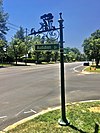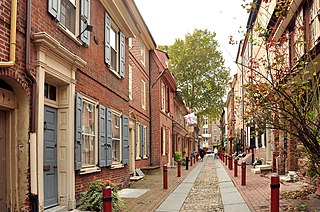| Property name [4] | Address or location | Image | NRHP Status [5] | Description |
|---|
| 1-7 Center Street | |  | Eligibility undetermined | Former cooperage and stave factory operated from 1852 until c. 1880 by brothers Jacob and Franklin Goetz, sons of Joseph Goetz, founder and namesake of the hamlet of Getzville. |
| 23 Four Seasons West | |  | Eligible | Former home of oil magnate Franklin B. Hower, once situated on a 17-acre country estate. An unusual Neoclassical design built c. 1905 by an unknown architect. |
| 38 Richfield Road | |  | Eligibility undetermined | Side-gabled vernacular stone residence with 1920s-era front porch in Craftsman style. Possibly one of the oldest buildings in Amherst (estimates for its date of construction extend back to the 1810s); once part of the 100-acre cattle farm of pioneer settler Peter Hershey, where it may have served as a barn. |
| 58 Youngs Road | |  | Not eligible | Two-and-a-half-story clapboard residence built c. 1905 for smallholder and sometime hotelier Michael Albert; a typical example of vernacular farmhouse construction of the era. |
| 260 Campbell Boulevard | |  | Not eligible | Two-story vernacular Italianate building erected c. 1860 by pioneer settler Charles Dean which, at varying times, has served a range of civic functions in the hamlet of Getzville: tavern, post office, court house, dance hall, and roadside inn for travelers along the Canandaigua and Niagara Falls Railroad. |
| 4030 Rensch Road | |  | Eligible | Built c. 1855 by German-born farmer Gottfried Kuhl; one of a very few surviving stone houses dating back to the pioneer era of the town's early history. Vernacular farmhouse design with Greek Revival pedimented portico in front. |
| Buffalo Academy of the Sacred Heart Main Building | 3860 Main Street |  | Eligible | 1930 Colonial Revival Roman Catholic girls' school building designed by Bley & Lyman. Sacred Heart was founded by the Sisters of St. Francis in 1877 and originally located in downtown Buffalo. |
| Coplon Mansion at Daemen University | 4380 Main Street |  | Eligible | Built in 1919 from an Italian Renaissance-style design by Buffalo architect Louis Greenstein; served as the country home of furniture merchant Samuel Coplon. Purchased by Daemen University in 1956 who used it first as student housing and then for classrooms and offices. |
| Country Club of Buffalo Stone House | 251 Youngs Road |  | Eligible | Built c. 1840s of locally quarried Onondaga limestone for James S. Youngs; one of a very few surviving pioneer-era stone houses in Amherst and a typical example of Greek Revival-influenced vernacular farmhouse architecture of the era. Now owned by the Country Club of Buffalo. |
| Entranceways at Kensington Avenue at Roycroft Boulevard | |  | Eligibility undetermined | Decorative stone walls and lamp posts marking the entrance to an early suburban subdivision. |
| Entranceway at Main Street at Darwin Drive | |  | Listed | Decorative ashlar lamp posts and wrought-iron sidewalk gates built in 1927 to mark the entrance to an early suburban subdivision. |
| Entranceway at Main Street at Getzville Road | |  | Eligibility undetermined | Decorative stone walls marking the entrance to an early suburban subdivision, a portion of which was built c. 1820 and is the oldest such stone wall remaining along Main Street. |
| Entranceway at Main Street at High Park Boulevard | |  | Listed | Decorative ashlar lamp posts and walls built in 1916 to mark the entrance to an early suburban subdivision. |
| Entranceway at Main Street at Lafayette Boulevard | |  | Listed | Decorative stone walls, posts, and roofed arched gateways built c. 1920 to mark the entrance to an early suburban subdivision. |
| Entranceways at Main Street at Lamarck Drive and Smallwood Drive | |  | Listed | Decorative stone walls, posts, and prominent Tudor Revival-style metal-roofed gatehouses built in 1926 to mark the entrance to an early suburban subdivision. |
| Entranceway at Main Street at LeBrun Road | |  | Listed | Decorative ashlar lamp posts and walls built in 1916 to mark the entrance to an early suburban subdivision. |
| Entranceway at Main Street at Roycroft Boulevard | |  | Listed | Decorative brick lampposts and semicircular half-height stone walls built in 1918 to mark the entrance to an early suburban subdivision. |
| Entranceway at Main Street at Westfield Road and Ivyhurst Road | |  | Listed | Decorative ashlar posts and walls built in 1920 by merchant-turned-real estate developer John Sattler to mark the entrance to an early suburban subdivision. |
| Gethsemane Cemetery Stone Chapel | 203 Reist Street |  | Eligibility undetermined | Gothic-style cemetery chapel built in 1902 on the former property of the Franciscan sisters' St. Mary of the Angels Motherhouse. |
| Goodyear Water Tower | east side of Old Tower Lane between Raine Drive and Northill Drive |  | Eligible | The only known octagonal water tower in Erie County, built c. 1920 to supply water to the Josephine Goodyear Convalescent Home for Children. |
| Haussauer House | 1000 North Forest Road |  | Not eligible | One-and-a-half-story Craftsman bungalow built c. 1910 as home of farmer-turned-National Guardsman Henry G. Haussauer. |
| Hedstrom Gate House | 4196 Main Street |  | Eligible | Unique large house on what was once the 97-acre country estate of coal merchant Arthur Hedstrom, built in 1904 as a combination of two earlier buildings dating to c. 1820 and c. 1850. Site of last operational toll gate along the Buffalo and Williamsville Macadam Road, decommissioned 1899. |
| Maple & North Forest Schoolhouse | 1323 North Forest Road |  | Not eligible | The only former one-room brick schoolhouse in Amherst that remains in its original location, built c. 1860 for District #17. |
| Mennonite Meeting House | 5178 Main Street |  | Listed | Vernacular Greek Revival-style building erected in 1834 of locally quarried limestone as house of worship for an Anabaptist community that included many of the town's founding families. In use as a church until 1981; now houses a branch location of Evans Bank. |
| Park School Stone House | 4635 Harlem Road |  | Eligible | Oldest building in the hamlet of Snyder, built c. 1831 as home of pioneer settler John Schenck. Reputed to have been a station on the Underground Railroad under a subsequent owner. Now owned by the Park School of Buffalo. |
| Rosary Hall at Daemen University | 4380 Main Street |  | Eligible | Designed in 1910 by prominent Buffalo architect George Cary; home first to insurance executive George Crouch and then to Irvin Airchute Company cofounder George Waite; now owned by Daemen University. Italian Renaissance style with prominent Mediterranean Revival influences. |
| St. Mary of the Angels Motherhouse | 400 Mill Street |  | Listed | Collegiate Gothic convent designed in 1928 for the Sisters of Saint Francis by Dietel & Wade; now a senior housing facility and part of Amherst State Park. |
| Stimm House | 895 North Forest Road |  | Eligible | Former home of civil engineer Henry Stimm, designed in 1942 by architect Sebastian Tauriello; International Style with heavy influence from Frank Lloyd Wright's contemporaneous work (more specifically, its design is said to be loosely based on Fallingwater). |
| Street sign at Main Street at Audubon Drive | |  | Eligibility undetermined | Decorative wrought iron street sign built c. 1920s to mark the entrance to an early suburban subdivision. |
| Street sign at Main Street at Burbank Drive | |  | Eligibility undetermined | Decorative wrought iron street sign built c. 1920s to mark the entrance to an early suburban subdivision. |
| Street sign at Main Street at Burroughs Drive and Darwin Drive | |  | Eligibility undetermined | Decorative wrought iron street sign built c. 1920s to mark the entrance to an early suburban subdivision. |
| Williamsville South High School | 5950 Main Street |  | Listed | 1950 Colonial Revival public high school building designed by Duane Lyman. |










































